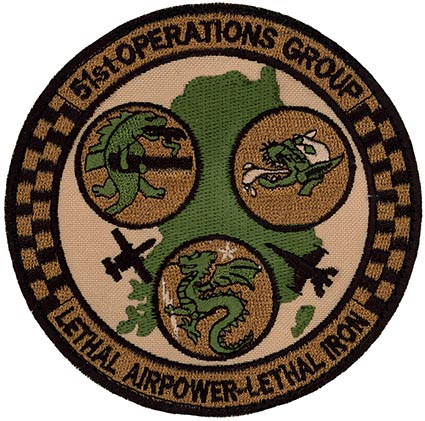Description
Korean computer made/mounted on velcro 4.0 inch-100mm
51st OPERATIONS GROUP (PACAF)
Lineage. Established as 51 Pursuit Group (Interceptor) on 20 Nov 1940. Activated on 15 Jan 1941. Redesignated: 51 Pursuit Group (Fighter) on 12 Mar 1941; 51 Fighter Group on 15 May 1942. Inactivated on 13 Dec 1945. Activated on 15 Oct 1946. Redesignated 51 Fighter-Interceptor Group on 1 Feb 1950. Inactivated on 25 Oct 1957. Redesignated: 51 Tactical Fighter Group on 31 Jul 1985; 51 Fighter Group on 10 Sep 1990. Activated on 1 Oct 1990. Redesignated 51 Operations Group on 7 Feb 1992.
Assignments. Southwest Air District (later, 4 Air Force), 15 Jan 1941; 9 Pursuit Wing, 2 Jun 1941 (attached to 4 Air Force until 20 Jun 1941); 4 Bomber Command, 19 Sep 1941-Jan 1942 (attached to 4 Interceptor Command, 14 Oct 1941-unkn); 10 (later, Tenth) Air Force, c. 14 Mar 1942; Fourteenth Air Force, 12 Sep 1943 (attached to Tenth Air Force until 1 Oct 1943); 69 Bombardment (later, 69 Composite) Wing, Oct 1943; Fourteenth Air Force, 25 Aug 1945; Army Air Forces, India-Burma Theater, Sep-Nov 1945. 301 Fighter Wing, 15 Oct 1946; 51 Fighter (later, 51 Fighter-Interceptor) Wing, 18 Aug 1948-25 Oct 1957 (attached to 8 Fighter-Bomber Wing, 26 Sep-12 Oct 1950; Detachment 1, Twentieth Air Force, 16 Aug 1954-1 Mar 1955; Detachment 1, 313 Air Division, 1-15 Mar 1955). 51 Tactical Fighter (later, 51; 51 Fighter) Wing, 1 Oct 1990-.
Operational Components. Squadrons. 4 Fighter: attached 20 Feb 1947-20 Sep 1950. 16 Pursuit (later, 16 Fighter; 16 Fighter-Interceptor): 15 Jan 1941-7 Dec 1945 (detached Jul 1942-19 Oct 1943); 15 Oct 1946-15 Oct 1957 (detached 3-28 Apr 1955, 1 Jun-1 Jul 1955, and 1 Jul-25 Oct 1957). 19 Tactical Air Support: 1 Oct 1990-1 Oct 1993. 25 Pursuit (later, 25 Fighter; 25 Fighter-Interceptor; 25 Fighter): 15 Jan 1941-12 Dec 1945; 15 Oct 1946-25 Oct 1957 (detached 28 Apr-1 Jun 1955 and 1 Jul-25 Oct 1957); 1 Oct 1993-. 26 Pursuit (later, 26 Fighter; 26 Fighter-Interceptor): 15 Jan 1941-13 Dec 1945; 15 Oct 1946-1 Oct 1957 (detached 20 Sep 1950-31 Jul 1954, 10 Nov-11 Dec 1954, and 11 Jul 1955-1 Oct 1957). 36 Tactical Fighter (later, 36 Fighter): 1 Oct 1990-. 38 Rescue (later, 38 Rescue Flight): 1 Feb 1993-15 Feb 1996. 39 Fighter-Interceptor: attached 1 Jun 1952-14 Jul 1954. 68 Fighter-All Weather: attached 25 Sep-9 Oct 1950. 80 Fighter-Bomber: attached 25 Sep-20 Dec 1950. 449 Fighter: 26 Aug 1943-13 Dec 1945 (detached 26 Aug-19 Oct 1943). Flight. 55 Airlift: 1 Jul 1992-15 Dec 2007.
Stations. Hamilton Field, CA, 15 Jan 1941; March Field, CA, 20 Jun 1941-11 Jan 1942; Karachi, India, 14 Mar 1942; Dinjan, India, 10 Oct 1942; Kunming, China, 2 Oct 1943; India, Sep-16 Nov 1945; Ft Lewis, WA, 12-13 Dec 1945. Yontan Adrm, Okinawa, 15 Oct 1946; Naha Afld (later, Naha AB), Okinawa, 22 May 1947; Itazuke AB, Japan, 22 Sep 1950; Kimpo AB, South Korea, 24 Oct 1950; Itazuke AB, Japan, 3 Jan 1951; Tsuiki AB, Japan, 22 Jan 1951; Suwon AB, South Korea, 31 Jul 1951; Naha AB, Okinawa, 1 Aug 1954-25 Oct 1957. Osan AB, South Korea, 1 Oct 1990-.
Aircraft. P-40, 1941-1945; P-38, 1943-1945; P-51, 1944-1945. P-47, 1946-1947; F-80, 1947-1951; F-61, 1947-1950; F-82, 1949-1950; F-86, 1951-1957; F-94, 1954. F-16, 1990-; OA-10, 1990-; C-12, 1992-2007; HH-60, 1993-1995; A-10, 1998-.
Operations. During 1941, trained in the United States for fighter operations. After the Pearl Harbor attack of 7 Dec 1941, served as part of the defense force for the west coast. Moved to India via Australia and Ceylon, Jan-Mar 1942. Defended the Indian terminus of the “Hump” airlift route over the Himalaya Mountains between India and China and airfields in that area. Flew strafing, bombing, reconnaissance, and patrol missions in support of Allied ground troops during a Japanese offensive in northern Burma in 1943. After moving to China in Oct 1943, defended the Chinese end of the Hump route and air bases in the Kunming area. Attacked Japanese shipping in the Red River delta of Indochina and supported Chinese ground forces in their late 1944 drive along the Salween River. Inactivated after returning to India and then the United States in the autumn of 1945. Between 1946 and 1950, trained and served as part of the occupation force and provided air defense for Okinawa and the Ryukyu Islands. Flew armed reconnaissance and close air support missions over Korea from Japan, Sep-Oct 1950 and from South Korea Oct 1950-Jan 1951, when it moved back to Japan. The group continued to fly combat missions over Korea, staging through air bases at Taegu and Suwon. Flew air support, patrol, escort, interdictory, and reconnaissance missions, frequently engaging enemy jet fighters in air-to-air combat. After the Korean armistice on 27 Jul 1953, the group remained on alert, flew patrol missions, and participated in air defense exercises. After returning to Okinawa in Aug 1954, resumed air defense missions over the Ryukyu Islands. Frequently deployed squadrons to Taiwan and the Philippines on alert and air defense exercises. Became non-operational on 1 Jul 1957 and remained so until inactivation on 25 Oct 1957. Since 1990, trained and took part in a series of exercises to maintain combat readiness for the air defense of South Korea.
Service Streamers. None.
Campaign Streamers. World War II: India-Burma; China Defensive; China Offensive. Korea: UN Offensive; CCF Intervention; First UN Counteroffensive; CCF Spring Offensive; UN Summer-Fall Offensive; Second Korean Winter; Korea, Summer-Fall 1952; Third Korean Winter; Korea, Summer 1953.
Armed Forces Expeditionary Streamers. None.
Decorations. Distinguished Unit Citations: Korea, 28 Nov 1951-30 Apr 1952. Air Force Outstanding Unit Awards: 1 Oct 1992-30 Sep 1994; 1 Nov 1995-31 May 1997; 1 Oct 2002-30 Sep 2004. Republic of Korea Presidential Unit Citations: [22] Sep 1950-30 Jun 1951; 1 Jul 1951-31 Mar 1953.
Emblem. Group will use the wing emblem with the group designation in the scroll.
